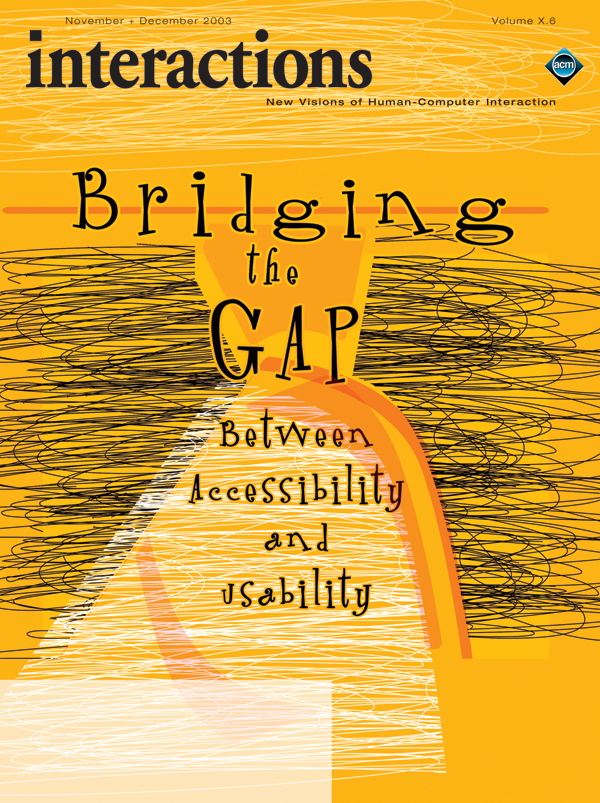Table of Contents
VOLUME X.6 November + December 2003
-
Editorial
-
Accessibilty is for everyone
Steven Pemberton
If you really want a fun experience, next time you browse the Web switch off images (if you use Microsoft Internet Explorer, go to "tools\internet options\advanced\multimedia" and click on "show pictures"). This is a heartwarming experience, because it not only gives you a taste of how people with low…
-
-
Research alert
-
Improving graphical information system model use with elision and connecting lines
Jouni Huotari, Kalle Lyytinen, Marketta Niemelä
We studied the impact of large screens and of two promising visual integration techniques, elision and connecting lines, which can decrease the cognitive efforts of designers to read diagrams. We conducted a laboratory experiment using 84 computer-science students to investigate the impact of these techniques on the accuracy of…
-
-
What's happening
-
What’s happening
Marisa Campbell
Seminar "The Science and Art of Effective Web and Application Design" November 12-14, 2003 Brussels, Belgium "The Science and Art of Effective Web and Application Design" is a survey of the best practices in Web design using a user-centered design process framework. Winning Web sites are those that balance…
-
-
Business
-
Managing interdisciplinary relationships
Elizabeth Rosenzweig, Joel Ziff
User-centered design and usability have gained precious ground in getting recognition of users' needs in the development process. More companies than ever before have usability labs. More universities include human factors, engineering psychology, and usability in their curriculums. We've identified and overcome many of the hard obstacles: We've learned…
-
-
Design
-
Designing a visual 3-D interface
Ina Wagner, Rüdiger Lainer
An ongoing concern of the participatory design community is collaboration with end users in the design of new technology. However, in this debate the work practices of system designers have received little attention. This paper describes the design of an interactive, navigable, three-dimensional world for use by architects. The…
-
-
HCI and the Web
-
Enterprise information architecture
William Hudson
Lou Rosenfeld was recently in London presenting his one-day seminar on enterprise information architecture. I have been doing a lot of work with intranets lately, so I thought it would be useful to attend. No one dealing with Web site development in a large organization would have any trouble…
-
-
Book review
-
Information architecture
Kathy Gill
When content streams 24 hours a day from multiple channels, the rules of navigation change. Designers need to rethink how they can make the journey more meaningful. Richard Saul Wurman, Information Anxiety 2 Information Architecture: Blueprints for the Web is one author's effort to illustrate how the designer's work…
-
-
Conference preview and calendar
-
Conference preview and calendar
Marisa Campbell
Preview The starting trajectory of the next millennium can be characterized largely by the progress of computing and communications technology. Cheaper and faster processors, storage, and networks combined with better user interfaces, have now spawned the incredible growth of the Internet and related services. Too often, however, system complexity,…
-
-
Reflections
-
So big, so bad, so often
Steven Pemberton
So as I write we're in the grip of the worst virus attack ever. I'm getting dozens of them per hour in my mailbox, and dozens more automatic replies from mail servers that think I have sent them a virus, because they don't realize that there is such a…
-
-
Fast forward
-
The emotion commotion
Aaron Marcus
A tidal wave of interest in emotions is brewing among user-interface professionals. Have you heard the rumblings of this oncoming tsunami? At ACM SIGCHI's CHI 2003 conference a few months ago, Prof. Jodi Forlizzi, of the Human-Computer Interaction Institute and School of Design at Carnegie-Mellon University, organized a well-attended…
-



